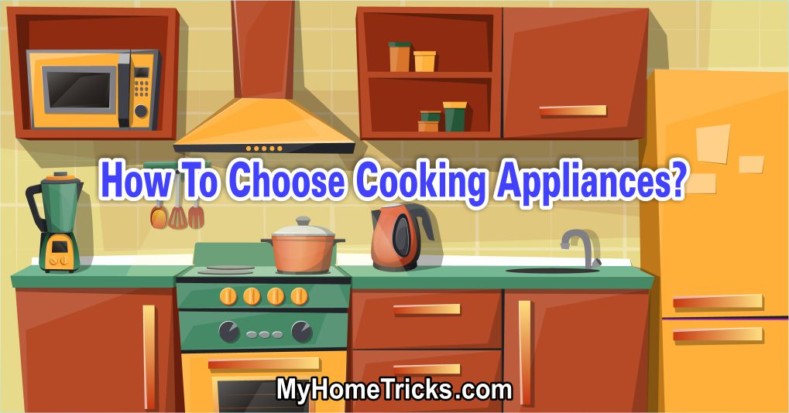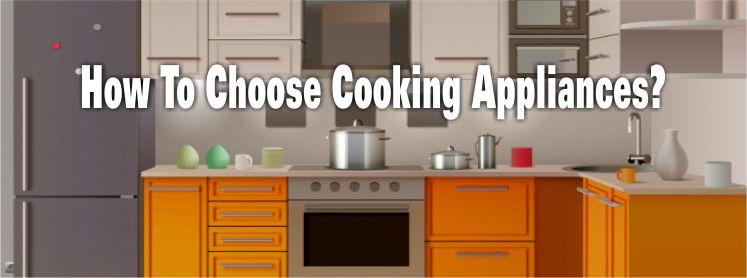Cooking Appliances
Choosing the right cooking appliances is a crucial decision, and it’s important to consider the different properties of each item. Some appliances require “strength” while others should be energy-efficient. Ergonomics is also important for some cooking appliances.
Choosing the Cooking Appliances
There are a wide variety of cooking appliances available, and everyone has different requirements when selecting them.
Cooking Appliances: Choosing a Stove
Stoves are a major financial investment and should be chosen for long-term use. When selecting an oven or stovetop, consider your cooking needs, including the advantages and availability of different fuels, and any space limitations in your kitchen. Choose a design that is attractive and practical, with few dirt traps to make cleaning easy.
Cooking Appliances: Choosing an Oven
When buying an oven, consider which features will be most useful for your lifestyle. Below are some features to consider:
- Capacity: Choose a large or double oven to provide flexibility, especially if you cook for a lot of people.
- Cleaning facilities: Choose an oven that is self-cleaning or has stay-clean features.
- Timer: Consider a timer to control cooking while you are busy.
- Convection: To encourage even cooking and reduce cooking times, choose a fan-assisted convection oven that circulates heat evenly.
Cooking Appliances: Selecting Burner Surface and Fuel Type
- Choosing burners: Select burners that are easy to clean. Consider ceramic burners, which also use electricity efficiently. When not in use, the cool surface can be used as a work surface for rolling out pastry or dough.
- Combining fuels: If you are able to combine fuels, consider two gas burners and two electric rings. This mix combines the safety advantages of electricity with the easy heat adjustment of gas burners and is useful in a power failure.
Cooking Appliances: Placing Burners
If you are planning a new kitchen, consider setting burners in a line rather than a square formation and set them well back from the front edge. Install a heatproof surface for resting hot saucepans in front of the burners.
Cooking Appliances: Considering Details
- Catalytic liners: Reduce oven cleaning by choosing an oven with a catalytic oven lining that carbonizes food spills. Alternatively, select a pyrolytic oven, which has a high-temperature, self-cleaning cycle.
- Built-in ovens: Choose a built-in oven, which is usually mounted at waist height, for convenient positioning.
- Eye-level grills: Choose an oven with the grill positioned at eye level if you want to check food frequently during cooking. The grill pan should have support and stops to prevent it from being pulled out too far.
Cooking Appliances: Resting a Hot Dish
Choose an oven with a strong door that pulls down rather than opening sideways. The door will provide a useful surface for hot casseroles or cookie sheets as they come out of the oven.
Cooking Appliances: Considering Safety
- Choosing warning lights: Pick a stove with controls that light up and warn you when the burners are hot, even if they are not glowing.
- Checking safety: Make sure that, if a gas stove-top has a lid for covering burners when not in use, the stove-top has a cutoff switch, and the lid is made of heatproof glass.
- Avoiding accidents If you have young children, install a stove guard to deter them from touching hot pots and pans. Turn saucepan handles inward to prevent children from pulling them down.
Cooking Appliances: Using a Stove
Whatever type of cooking you do most often, it is a good idea to be aware of your oven’s rate of energy consumption and to check regularly that it is running efficiently. Refer to the manufacturer’s handbook for tips on how to make good use of special functions.
Cooking Appliances: Checking Temperature
To ensure that your oven is accurate, use a thermometer to check its temperature regularly. Place an oven thermometer in the center of the middle shelf and heat the oven to 350°F (180°C). Then, compare the thermometer reading with the oven’s temperature.
Cooking Appliances: Cooking Efficiently
Here are some tips to cook efficiently:
- Saving energy: Turn off solid-element burners a few minutes before you finish cooking. The food will continue to cook on the residual heat.
- Preheating the oven: Allow the oven to preheat for at least 10 minutes. Arrange the oven shelves before turning on the oven to avoid losing heat or burning yourself.
- Setting a timer: Use a timer to monitor cooking times and avoid opening the oven door, which lowers the oven temperature.
- Avoiding scratches: Lift pans off ceramic burners instead of sliding them across to prevent damage.
Cooking Appliances: Saving Fuel
To use fuel economically, cook a complete meal in the oven at the same time. Place dishes that need the highest temperatures at the top of the oven and other dishes on the lower shelves.
Wipe up cooking spills on a burner or inside the oven immediately after they occur. Once they harden or burn onto the surface, you will have to use a commercial cleaner to remove them. Before cleaning an electric oven or burner, switch off the power.
Cooking Appliances: Cleaning Efficiently
Here are some tips to clean efficiently:
- Reducing cleaning: Stand pies and casseroles on a cookie sheet in the oven to catch spills.
- Wiping a ceramic surface: Wipe up fruit juice, sugar, and acidic food spills on ceramic burners immediately, as they may cause etching or pitting on the surface.
- Cleaning shelves: Wash oven racks in the dishwasher, remove them before the drying cycle, and wipe them with a cloth. Alternatively, place them on an old towel in the tub and soak them in a solution of ammonia and hot water to loosen food deposits.
- Saving energy: Start a self-cleaning cycle when the oven is still warm to save energy.
Cooking Appliances: Removing Burned Food
If food burns onto a burner surround, turn off the heat, let it cool, and cover it with a cloth wrung out in a solution of water and dishwashing liquid. Let it stand for two hours, then wipe it clean with a damp cloth.
Cooking Appliances: Money Saving Tip
To clean rust from chrome trim, wrap a piece of aluminum foil around your finger, shiny side out, and rub it on the affected area. Buff it up with a cloth dipped in rubbing alcohol.
Cooking Appliances: Using a Microwave
Microwaves are quick, easy, and economical for cooking. Regardless of how many people you cook for, a microwave can be an invaluable addition to the kitchen, saving time and energy.
Cooking Appliances: Choosing a Microwave
Before buying a microwave, consider the useful features of many models.
- Power: Most full-power ovens use 650—750 watts. The higher the wattage, the shorter the cooking times.
- Controls: Digital controls provide more accurate timings than dial controls.
- Turntables: Ensure that the oven has a turntable. If it does not, the food will have to be turned in manually.
- Browning option: This option will add rich, golden color and crispness to food.
- Cleaning: Look for self-cleaning interior panels on combination ovens to simplify cleaning.
- Compact models: If kitchen space is limited, choose an under-cabinet model.
.
Cooking Appliances: Learning Basic Skills
- Adapting recipes: To adapt a conventional recipe for the microwave, reduce the cooking time by about two-thirds.
- Adjusting cooking times: When doubling recipe amounts for the microwave, increase the cooking time by one-quarter to one-third. When halving recipe amounts, reduce the cooking time by approximately one-third.
- Checking temperature: Use a microwave thermometer to check that food is thoroughly cooked. Frozen dinners should reach 158°F (70°C).
- Adding color: To enhance the color of food cooked in a microwave, top savory dishes with toasted nuts or a sprinkling of paprika, and top sweet dishes with toasted nuts, brown sugar, or ground spices.
Increasing Capacity
Stacking plates: Use plate-stacking rings to cook two portions of food at once and increase the cooking time by ½ minute. Move the plates around halfway through cooking.
Using Shelves
Buy shelves and trivets, both of which are available as microwave accessories, so that you can cook more than one item at a time. Alternatively, choose a microwave with a shelf.
Microwaving Safely
Follow a few basic guidelines to ensure that you use a microwave safely, choose suitable containers, and cook food thoroughly. Used correctly, microwaves are versatile cooking appliances; they cook and reheat food in a fraction of the time it would take in a conventional oven.
Cooking Thoroughly
Arranging food: For safety, make sure food is cooked thoroughly. Distribute it evenly in a dish, and cook wedge-shaped items, such as pears or fish fillets, with the narrow ends pointing to the center of the dish.
Choosing Dishes
Checking heat resistance: To ensure that a dish will not overheat, place it in a microwave with a cup of cold water on High for two minutes. The water should heat up and warm the cup, while the dish should remain cold.
Safety
- Following instructions: Read the manufacturer’s handbook, and follow cooking instructions on packaged foods.
- Avoiding metal: Do not use metal dishes, dishes that have metal decoration, or kitchen foil in a microwave.
- Supervising cooking: Always avoid letting foods cook unattended, since some high-sugar foods may catch fire.
- Cooking and reheating: Make sure that microwaved food is thoroughly and evenly cooked before serving.
More:
Tip: If you would like to read more about the “Cooking Appliances“, you can take a look at the “tags” below.






